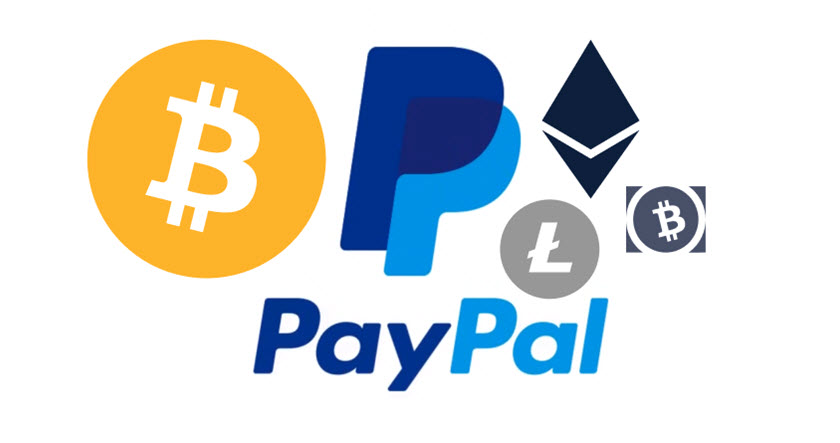PayPal’s announcement that it would open its door to crypto a couple months back made for some big news. Even though the payments giant was somewhat vague regarding what the offering would look like, many believe that the announcement was one of the key driving forces that pushed bitcoin on a months-long price surge.
Initially, PayPal said that U.S. users would be able to purchase and store tokens through their PayPal account, with plans to “add more utility” for the cryptocurrencies in PayPal’s e-wallets in early 2021. As first announced by a Reuters exclusive, PayPal confirmed that it would move along with its gradual adoption by making cryptocurrency checkouts available as of Tuesday, “a move that could significantly boost use of digital assets in everyday commerce.”
Currently, bitcoin, bitcoin cash, ether, and litecoin (the four cryptocurrencies PayPal allows in wallets) are eligible for use.
Credit cards and cryptocurrencies side-by-side in your PayPal wallet
Talking to Reuters, PayPal President and CEO Dan Schulman described these additional capabilities this way:
This is the first time you can seamlessly use cryptocurrencies in the same way as a credit card or a debit card inside your PayPal wallet.
Well, in all honesty, not quite the same way.
According to Coindesk, during a purchase, a user’s cryptocurrencies are “seamlessly converted into U.S. dollars or other fiat currencies” for the purpose of the transaction. The seller receives U.S. dollars rather than bitcoin or ether.
That might be disappointing to pure crypto enthusiasts. Consider it from the point of view of the business owner, though. Your favorite food truck entrepreneur might be one of the 29 million merchants who’s perfectly happy to accept a PayPal payment. Would she be just as happy if, at the end of the day, she now sees line items for bitcoin, ether, litecoin and bitcoin cash on daily transaction report? Does her bank accept crypto deposits? Does she even have a crypto wallet?
By completing the transaction in a local currency, PayPal eliminated the need for any additional complexities for merchants. PayPal removed the downside risk of cryptocurrency volatility during the settlement period (the time between a transaction and the funds actually getting deposited into the merchant’s account, 1-2 days later). This is basically the same behind-the-scenes process that happens when you use your credit card to buy souvenirs from Thailand to bring home to your friends. You don’t see a charge for 1,500 baht on your statement; instead, your credit card company handles the exchange behind the scenes. The souvenir seller receives a deposit in baht, you pay your bill in dollars, and everything’s simple.
Unlike most credit card companies, PayPal doesn’t charge a transaction fee: “a cryptocurrency conversion spread will be built into the conversion from crypto to USD.”
In Shulman’s words, this is no less than:
…a new way for businesses to get paid. Enabling cryptocurrencies to make purchases at businesses around the world is the next chapter in driving the ubiquity and mass acceptance of digital currencies.
“Ubiquity” and “mass acceptance” are pretty exciting… Clearly, many people think so. Coindesk reports, “the news was enough to drive up the currencies involved, particularly BTC, which rose more than $1,000.”
There are still some limits, though
In contrast to its fiat options, PayPal users are still limited in sending and receiving cryptocurrencies. They must purchase cryptocurrencies through PayPal using a linked bank account. Then they can either opt to hold (or perhaps hodl) them within the account (or use them for buying from any merchant who accepts PayPal). Only one type of cryptocurrency can be used per transaction, so you have to already have enough ether or bitcoin cash available to cover your purchase.
This is definitely an improvement, but isn’t quite the free back-and-forth transactions between accounts we see with fiat currencies. Fortunately, PayPal’s announcement seems to imply these could be options in the not-too-distant future.
The company’s own website goes a step further with the notion. The landing page for crypto offers a step-by-step introduction that might not even be necessary these days. One line stands out in particular: “Crypto is short for cryptocurrency. Many believe that crypto could one day be as commonly used as cash and credit.”
At this point, it’s difficult to make anything but a bullish long-term investment case for cryptocurrencies as people begin to treat them as a more versatile and reliable alternative to fiat currencies. Some have been warning that governments could try to grab a hold of the reins precisely because of this, but the ever-growing decentralized crypto market is its own failsafe against government clampdowns.







